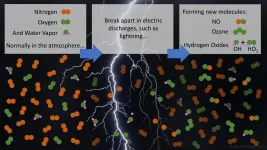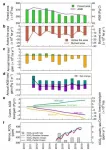Digital mental health interventions for young people are perceived promising, but are they effective
2021-04-29
(Press-News.org) April 29, 2021 -An increasing number of digital mental health interventions are designed for adolescents and young people with a range of mental health issues, but the evidence on their effectiveness is mixed, according to research by Columbia University Mailman School of Public Health and Spark Street Advisors.
Computerized cognitive behavioral therapy was found effective for anxiety and depression in adolescents and young people holding promise for increasing access to mental health treatment for these conditions. However, the effectiveness of other digital interventions, including therapeutic video games, mobile apps, or social networking sites, and addressing a range of other mental health outcomes remain inconclusive. The findings are published online in the journal JMIR Mental Health.
According to UNICEF, nearly 1 in 5 adolescents experience a mental health disorder each year but because of barriers to accessing and seeking care, most remain undiagnosed and untreated.
"While there is evidence that some interventions can be effective when delivered digitally, it is still somewhat of a wild west when it comes to digital mental health apps," said Nina Schwalbe, adjunct assistant professor of Population and Family Health at Columbia Mailman School.
The researchers conducted an analysis of 18 systematic reviews and meta-analyses of digital health interventions. In addition to the findings on computerized cognitive behavioral therapy, some therapeutic areas of digital interventions improved outcomes relative to controls for those who are on the waitlist for services, suggesting that the interventions can be used for supplementing and supplanting traditional mental health treatment in cases where access to care is limited or wait times to access are long.
The Investigators point out that the vast majority - over 90 percent - of interventions studied are implemented in high-income countries, with very little information about the background of participants. Therefore, the generalizability of the findings to young people from different socioeconomic, cultural, racial, or other communities is weak. ""It is critical to assess the effectiveness among different racial and ethnic groups and across geographies," observed Susanna Lehtimaki of Spark Street Advisors.
"There was also no indication of costs of developing the tools or long-term benefits," noted Susanna Lehtimaki of Spark Street Advisors. "Moving forward with effective digital health interventions, it will be important to understand how they fit within the public health ecosystem and to what extent they are effective across a range of settings with different resources or populations."
According to the research, digital mental health interventions were well accepted by those 10 to 24 years of age, however, dropout was common and adherence weak. Engagement of a health professional, peer, or parent as part of the digital intervention were found to strengthen the effectiveness.
Schwalbe notes, "In the spirit of "do no harm" it is really important that the excitement over the promise of digital mental health interventions does not cloud the need for high quality effectiveness studies in a range of settings and with a diverse group of youth." She also notes, "it should go without saying that adolescents also need to be consulted in every stage of the design process and while it may be assumed that young people prefer digital services, we need to continually challenge whether this is true."
INFORMATION:
Co-authors include Jana Martic, Spark Street Advisors; Brian Wahl, Spark Street Advisors and Bloomberg School of Public Health; and Katherine Foster, University of Washington.
Columbia University Mailman School of Public Health
Founded in 1922, the Columbia University Mailman School of Public Health pursues an agenda of research, education, and service to address the critical and complex public health issues affecting New Yorkers, the nation and the world. The Columbia Mailman School is the seventh largest recipient of NIH grants among schools of public health. Its nearly 300 multi-disciplinary faculty members work in more than 100 countries around the world, addressing such issues as preventing infectious and chronic diseases, environmental health, maternal and child health, health policy, climate change and health, and public health preparedness. It is a leader in public health education with more than 1,300 graduate students from 55 nations pursuing a variety of master's and doctoral degree programs. The Columbia Mailman School is also home to numerous world-renowned research centers, including ICAP and the Center for Infection and Immunity. For more information, please visit http://www.mailman.columbia.edu.
ELSE PRESS RELEASES FROM THIS DATE:
2021-04-29
Archeologists have learned a lot about our ancestors by rummaging through their garbage piles, which contain evidence of their diet and population levels as the local flora and fauna changed over time.
One common kitchen scrap in Africa -- shells of ostrich eggs -- is now helping unscramble the mystery of when these changes took place, providing a timeline for some of the earliest Homo sapiens who settled down to utilize marine food resources along the South African coast more than 100,000 years ago.
Geochronologists at the University of California, Berkeley, and the Berkeley ...
2021-04-29
The European house mouse has invaded nearly every corner of the Americas since it was introduced by colonizers a few hundred years ago, and now lives practically everywhere humans store their food.
Yet in that relatively short time span -- 400 to 600 mouse generations -- populations on the East and West Coasts have changed their body size and nest building behavior in nearly identical ways to adapt to similar environmental conditions, according to a new study by biologists at the University of California, Berkeley.
To make these adaptations -- at least in the case of body size -- mice in the Western United States ...
2021-04-29
Research has shed new light on the impact of humans on Earth's biodiversity. The findings suggest that the rate of change in an ecosystem's plant-life increases significantly during the years following human settlement, with the most dramatic changes occurring in locations settled in the last 1500 years.
An international research team studied fossilised pollen dating back 5000 years, extracted from sediments on 27 islands. By analysing the fossils they were able to build up an understanding of the composition of each island's vegetation and how it changed from the oldest to the most recent pollen samples.
The study was led by Dr Sandra Nogué, Lecturer in Palaeoenvironmental ...
2021-04-29
Researchers at Karolinska Institutet in Sweden have discovered a mechanism through which meningitis-causing bacteria can evade our immune system. In laboratory tests, they found that Streptococcus pneumoniae and Haemophilus influenzae respond to increasing temperatures by producing safeguards that keep them from getting killed. This may prime their defenses against our immune system and increase their chances of survival, the researchers say. The findings are published in the journal PLoS Pathogens.
"This discovery helps to increase our understanding of the mechanisms these bacteria use to evade our normal immune defenses," ...
2021-04-29
Scientists have been able to track how a multi-drug resistant organism is able to evolve and spread widely among cystic fibrosis patients - showing that it can evolve rapidly within an individual during chronic infection. The researchers say their findings highlight the need to treat patients with Mycobacterium abscessus infection immediately, counter to current medical practice.
Around one in 2,500 children in the UK is born with cystic fibrosis, a hereditary condition that causes the lungs to become clogged up with thick, sticky mucus. The condition tends to decrease life expectancy among patients.
In recent years, M. abscessus, a species of multi-drug resistant bacteria, has emerged as a significant global threat to individuals with cystic fibrosis and other lung diseases. ...
2021-04-29
Considerable gap in evidence around whether portable air filters reduce the incidence of COVID-19 and other respiratory infections
There is an important absence of evidence regarding the effectiveness of a potentially cost-efficient intervention to prevent indoor transmission of respiratory infections, including COVID-19, warns a study by researchers at the University of Bristol.
Respiratory infections such as coughs, colds, and influenza, are common in all age groups, and can be either viral or bacterial. Bacteria and viruses can become airborne via talking, coughing or sneezing. The current global coronavirus (COVID-19) pandemic is also spread primarily by airborne droplets, and to date has led to over three million deaths ...
2021-04-29
Lightning bolts break apart nitrogen and oxygen molecules in the atmosphere and create reactive chemicals that affect greenhouse gases. Now, a team of atmospheric chemists and lightning scientists have found that lightning bolts and, surprisingly, subvisible discharges that cannot be seen by cameras or the naked eye produce extreme amounts of the hydroxyl radical -- OH -- and hydroperoxyl radical -- HO2.
The hydroxyl radical is important in the atmosphere because it initiates chemical reactions and breaks down molecules like the greenhouse gas methane. OH is the main driver of many compositional changes in the atmosphere.
"Initially, we looked at these huge OH and HO2 signals found in the clouds and asked, what is wrong with our instrument?" said William ...
2021-04-29
Researchers in the materials department in UC Santa Barbara's College of Engineering have uncovered a major cause of limitations to efficiency in a new generation of solar cells.
Various possible defects in the lattice of what are known as hybrid perovskites had previously been considered as the potential cause of such limitations, but it was assumed that the organic molecules (the components responsible for the "hybrid" moniker) would remain intact. Cutting-edge computations have now revealed that missing hydrogen atoms in these molecules can cause massive efficiency losses. The findings are published in ...
2021-04-29
An international team led by Xiangming Xiao, George Lynn Cross Research Professor in the Department of Microbiology and Plant Biology, University of Oklahoma College of Arts and Sciences, published a paper in the April issue of the journal Nature Climate Change that has major implications on forest policies, conservation and management practices in the Brazilian Amazon. Xiao also is director of OU's Center for Earth Observation and Modeling. Yuanwei Qin, a research scientist at the Center for Earth Observation and Modeling, is the lead author of the study.
For the study described in the paper, "Carbon loss ...
2021-04-29
As part of a laboratory experiment, Rebecca Holmes examined water bottles that had been acquired from abroad expecting to find bisphenol A (BPA), a human-made component commonly found in polycarbonate plastics used to make consumer products.
What she found, however, was that those water bottles were just fine, yet some control bottles purchased in the United States and supposedly BPA-free actually contained traces of the chemical now thought to negatively impact heart health.
Holmes, a researcher formerly in the laboratory of Hong-Sheng Wang, PhD, professor in the University of Cincinnati Department of Pharmacology and Systems Physiology, was working on her master's degree in molecular, cellular and biochemical ...
LAST 30 PRESS RELEASES:
[Press-News.org] Digital mental health interventions for young people are perceived promising, but are they effective







